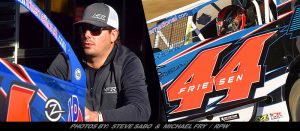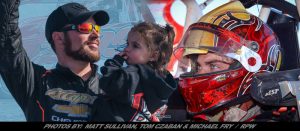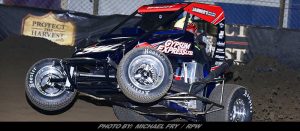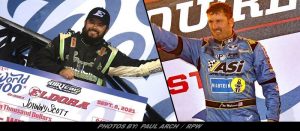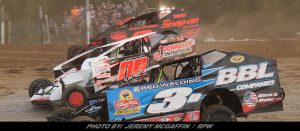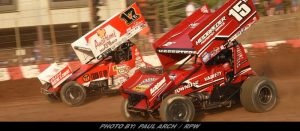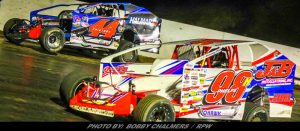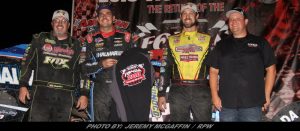NASCAR Welcomes Five Legends To It’s Most Hallowed Hall
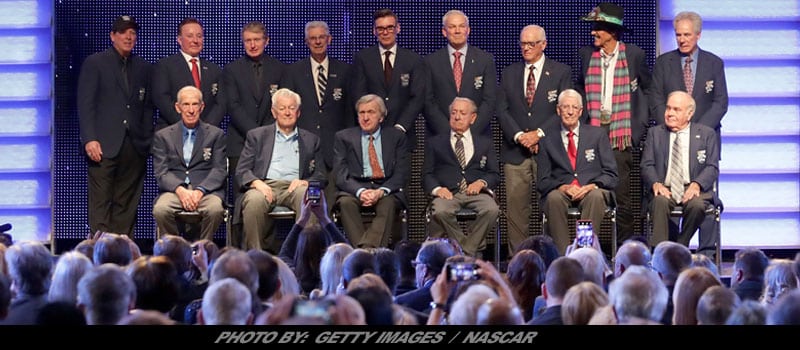

Column By: JOHN DOUGLAS / RPW – CHARLOTTE, NC – Each year, as the promise of a new season looms large on the horizon, the NASCAR community congregates at the NASCAR Hall of Fame in downtown Charlotte to recognize those who have made contributions to the sport as a driver, owner, media personality or ambassador.
Red Byron, Ron Hornaday Jr., Ken Squier, Ray Evernham and Robert Yates were chosen from 20 nominees to forever be enshrined inside the walls of NASCAR’s most hallowed of grounds.
Red Byron was NASCAR’s first championship driver. Winning the Modified Stock championship in 1948, then the Strictly stock championship in ’49, Byron was the first champion of the series that became the Monster Energy NASCAR Cup Series. His two wins in that championship season propelled him to become one of the sport’s first widely known athletes.
During one of the many video productions honoring the nominees, Richard Petty simply stated, “ (Byron) Should have been one of the first chosen for this Hall of Fame.”
Members of Byron’s family accepted his Hall of Fame honors posthumously.
Ron Hornaday Jr.’s acceptance speech was far different than most. Coming from the short tracks of the west coast, Hornaday’s road to success started in the NASCAR Southwest Tour Series, winning back-to-back championships in 1992 and 1993. That was before moving on to drive for Dale Earnhardt in the NASCAR Truck Series in 1994 with the advent of Winter Heat exhibition events. His first full points season would come in 1995.
Hornaday’s four championships in the Truck Series are unmatched and he still holds the record for top 5 and top 10 finishes to this day. Yet even that doesn’t tell the whole story of the ‘rough around the edges, hard nosed’ racer who moved to the Southeast to become the face of an entire series.
It’s just as important to note what Hornaday gave the sport when not behind the wheel. He gave future Cup Series champions Kevin Harvick and Jimmie Johnson a couch…a place to rest their heads as they took the biggest risks of their lives trying to make it to the top. Hornaday was as much a facilitator for talent as a he was a talent himself and his unwavering passion for the Truck Series led to the Hall of Fame.
Ken Squier, from this writer’s perspective, is the most important person to ever walk into a NASCAR track that never drove a race car in competition. He gave this sport to all of us on a silver platter with a CBS logo emblazoned on it.
In 1979, Squier was instrumental in bringing NASCAR and CBS together for the first ever flag-to-flag coverage of the Daytona 500.
The Barre, VT announcer got his start at his father’s local radio station and began announcing races (sort of) from the back of an old truck with speakers on each side. Squier regaled the audience with the story of his then 15-year -old self, who was forced to hide during what turned into a riotous affair that brought law enforcement to the track to shut things down permanently.
Squier has never been a man who doesn’t have the exact words you want, and NEED, to hear in any scenario you could possibly fathom inside the realm of motorsports. His quick wit (which he still has to this day…it hasn’t wavered one bit), thoughtful words, and most of all, dedication to his craft of conveying not just the sport but the people in it, put him on another level that most aspire to, but very few will ever reach…if any.
Ray Evernham grew up in New Jersey, cutting his teeth in the racing world with some of the finest competitors to ever turn laps under the NASCAR banner. Some of those being the likes of Hall of Famers Richie Evans and Jerry Cook as well as former Daytona 500 Champion Geoff Bodine.
The attention to detail those racers put into their machines rubbed off on Evernham, in a way, and gave him the inspiration after stepping away from driving competition to work as a mechanic in the sport.
Fast forward a few years, to 1992, and the final race of the NASAR Cup Series season in Atlanta. A young Californian (transplanted to Indiana) Sprint Car driver had decided to come East and try his hands at the top tier of Stock Car racing. No, this isn’t the true story of Days of Thunder, although the stories are similar enough that you’d swear it could have been.
Rick Hendrick decided there was only one man to help guide that upstart with Gordon for a last name…Ray Evernham.
The skills he learned from the modified tour led him to become one of NASCAR’s greatest Crew Chiefs of all-time. Three Championships in four years and two Daytona 500 championships weren’t the only accomplishments Evernham achieved. His teamwork attitude revolutionized the concept of the pit stop, turning it into a sophisticated dance of speed and precision. No wasted movement. His theories took the average pit stop from 20-plus seconds down to low fifteen second territory.
Near the end of 1999, Evernham decided it was time for a long-forgotten part of NASCAR’s history make a return. Dodge, which had been famous for powering a vast majority of Richard Petty’s legendary success, was ready to enter the fray once again. It would be Evernham’s team that would be the flagship for the brand.
Though no championships came from the partnership, Bill Elliott’s career flourished once again in a red No. 9. Kasey Kahne was given his first Cup Series opportunity in that same car, also earning nine wins in cars owned by Evernham.
Ray’s friend, Jeff Gordon. and his son, Ray Jay, had the honors of inducting him into the Hall of Fame.
Robert Yates knew his spot in the NASCAR Hall of Fame was secure. He was thankful, proud and humbled by the gesture which was earned through his work ethic, his eye for talent and his willingness to spend hour upon hour trying to make every engine he ever built just a little bit better than the last.
Yates started his NASCAR Cup Series tenure with Holman-Moody building engines. Later, buying Ranier Racing (Changing the name to Robert Yates Racing), he hired Davy Allison to drive his No. 28 Texaco Havoline Ford. The pairing became one of the most notable in NASCAR’s history.
Sadly Allison lost his life in a helicopter crash in 1993 at his home track of Talladega in Alabama.
Dale Jarrett took the wheel of the team’s second car in 1996, after filling in for an injured Ernie Irvan during the previous year. Thus began one of NASCAR’s most potent combinations.
Driving the Ford Quality Care #88, Jarrett won the 1999 Cup Series championship and two Daytona 500’s, along with 26 other trips to victory lane. In 380 race in the 88 car Jarrett amassed some incredible numbers, including 188 top 10 finishes.
Jarrett’s relationship with Yates was strong , and one that he honored as he read Yates’ induction speech. Robert wrote it before his untimely death late in 2017 after a hard fought battle with cancer.
There wasn’t a dry eye in the house by the time the pre-recorded video package was completed.
This year’s Hall of Fame was by far one of the most emotional with the loss of Yates so prominent in the proceedings. It was also full of some of the most deserving recipients of its honors to date. The first champion driver…the first four-time Truck Series champion…the first flag-to-flag television announcer…the first to usher in a new youth movement in the sport which continues today.
Then, there’s Yates.
Robert Yates may have not been the first, but he was among the very best to ever turn a wrench and give talent the opportunity to succeed. Each of these men forever will be among the greatest this sport has ever seen and statistics aren’t enough to convey their lasting impact on a sport we all love.


